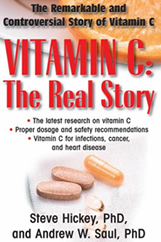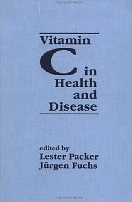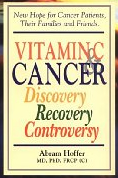Flu Shots: Pros and Cons / RisksFirst of all: Is it a Cold or the Flu? Click here to find out (lists symptoms for each)The following requires a visit to your ER:
Call Your Doctor You usually do not have to call your doctor right away if you have signs of a cold or flu. But you should call your doctor in these situations:
|
Flu, Viruses, and Vitamin C Megadoses: A Personal Statement
Vitamin C - the Key for Good Health
By Robert G. Smith, PhD
(Dr. Robert G. Smith is Research Associate Professor, Department of Neuroscience, University of Pennsylvania. His research interest is the function of retinal circuitry. He is a member of the Institute for Neurological Sciences and the author of several dozen scientific papers and reviews.)
Reprinted with permission from Orthomolecular Medicine News Service
(OMNS, November 17, 2009) Like most Americans, throughout most of my life I have occasionally been down with a virus. But for a long time, a simple cold for me started as a headache, sore throat and congestion in my nasal passages, and typically progressed to prolonged infection in my lungs, and a terrible cough. The whole experience took up to two weeks for recovery from the virus, and several more weeks for my lungs to recover.
In his book Vitamin C and the Common Cold (1), Linus Pauling explained that vitamin C, taken at the proper dose, can prevent a virus from taking hold in the body. This pioneering book, written back in 1970, was ignored by many doctors but was well-received by the public. One chemistry professor told me that he had heard of Pauling's book and the vitamin C therapy but didn't think taking a big dose of an acid, even a mild one like ascorbic acid, would be good for the body. As for me, I imagined Pauling was probably correct about the details he had researched, because he was a renowned scientist and knew much more than most about biochemistry. Perhaps, I thought, he had simply gotten some of the medical details wrong or had missed some of the important studies about the effects of vitamins.
But I started taking 1,000 mg of vitamin C every day and kept this up for several decades.
Two years ago, I decided to look further for myself. I looked online and found a recent book by Hickey and Roberts (2) that summarized 60 years of vitamin C research and revisited the issue of Dr. Pauling's rejection by the medical establishment. Pauling and a few brave physicians had continued research into the use of vitamin C to prevent illness and had gained a lot of new knowledge and intuition about its use. The book explained that all of the studies showing little effect of vitamin C had serious flaws. It also carefully debunked the myths about hazards of vitamin C use.
I also read Pauling's newer book on vitamin therapy, How to Live Longer and Feel Better (3), and was amazed at his clear explanation of individual differences in the need for essential nutrients. Pauling had been right all along, and now there was a lot of new knowledge about how to use vitamin C for best benefit.
Next, I found a book by Thomas Levy on the use of vitamin C to cure infectious disease. (4) All of these books contained numerous references to the scientific literature. So I started taking 2,000-3,000 milligrams of vitamin C every few hours, and more when I went to bed at night. This caused no discomfort and only occasionally produced a minor laxative effect from vitamin C that was unabsorbed.
 Then, if I ever got an infection, I followed Dr. Robert Cathcart's instructions about going to "bowel tolerance" of vitamin C. (5) Usually when I get a cold or the flu there is an initial period of several hours when I feel tired, with a slight headache, sometimes with a slight sore throat or sniffle. As the books described, I could stop the symptoms of the oncoming infection within an hour or two by taking a higher dose of vitamin C at shorter intervals (3,000-5,000 milligrams every 20 minutes). Did it work? Well, that first year I didn't get any colds or flu, though in previous years I usually had 2-3 colds.
Then, if I ever got an infection, I followed Dr. Robert Cathcart's instructions about going to "bowel tolerance" of vitamin C. (5) Usually when I get a cold or the flu there is an initial period of several hours when I feel tired, with a slight headache, sometimes with a slight sore throat or sniffle. As the books described, I could stop the symptoms of the oncoming infection within an hour or two by taking a higher dose of vitamin C at shorter intervals (3,000-5,000 milligrams every 20 minutes). Did it work? Well, that first year I didn't get any colds or flu, though in previous years I usually had 2-3 colds.
Continuing to read about vitamin C and its effects, I read the new Hickey and Saul (6) book. The authors presented a very clear rationale for ingesting vitamin C at a high level to bowel tolerance. Normally, the body does not take up vitamin C from the gut very efficiently at high doses. However, when the body is stressed with bacteria, viruses, or toxins, the need for vitamin C goes up tremendously, and the gut absorbs proportionately more.
Now, after two years of taking high doses of vitamin C whenever I feel symptoms of a cold or flu, I haven't had any colds or flu. I have found, exactly as Hickey and Saul report, that it is possible to feel the symptoms wax and wane in one's body in inverse proportion to the dose that one takes throughout the day. This is a helpful scientific observation that anyone can verify whenever one treats a cold or influenza with vitamin C. Although in previous years I typically got a secondary bacterial infection in my lungs, requiring antibiotics and another two weeks for recovery beyond the duration of the cold, now with my vitamin C therapy I simply don't get a cough at all, much less a prolonged bacterial infection. From this experience, it is obvious to me that vitamin C helps to strengthen the immune response.

It is also now obvious to me that all the years I had been taking 1,000 mg/day and continued to get two or three colds, the amount was simply not enough. I ride my bicycle in to work throughout the year, even when it is freezing cold in the winter, and this puts a severe stress on my lungs. The books I've read explain that any severe stress, for example, a low-grade bacterial infection, or an injury, increases the body's need for an anti-oxidant, and lowers the level of vitamin C in the blood. Although 1,000 milligrams of vitamin C per day does some good, it simply is not enough to suffice for the body's needs when an infection comes on.
Most animal species make in the neighborhood of 5,000-10,000 mg/day of vitamin C in their own bodies; this is the norm for all mammals except primates, some fruit eating bats, and guinea pigs. And it is known that during times of stress or illness, the majority of animal species dramatically increase their need and production of vitamin C.
We humans can respond to this increased need by taking mega-doses of vitamin C when we start to feel a virus taking hold. When we do so, our bodies will be able to fight it off more readily.

Every year there are a few reports ostensibly showing some problem with mega-doses of vitamin C. But after close scrutiny none have held true, and the Hickey and Saul book explains why very clearly. Every individual 2,000-3,000 milligram dose I take allows my body, according to Hickey's dynamic flow model, to eliminate any excess after the vitamin performs its function. No heartburn, sometimes a little gas, very little laxative effect, and this is reduced by lower doses. For me, this is a small price to pay for not having several prolonged three- to four-week periods per year during which I'm essentially out of operation with congestion and a terrible cough.
If everyone could read the Pauling, Levy and Hickey and Saul books, I imagine we'd have a lot less illness in our country. Does this mean that we could stop the current flu epidemic with vitamin C? I suspect that if clinics around the country could make the facts known about vitamin C and give some simple instructions about its use, then yes, this could be accomplished. That is, if we take large enough doses.
References:
(1) Pauling L. Vitamin C and the Common Cold. W.H. Freeman and Company, San Francisco, 1970. Also: Vitamin C, the Common Cold, and the Flu. W.H.Freeman, San Francisco, 1976.
(2) Hickey S and Roberts H. Ascorbate: The science of vitamin C. 2004. ISBN 1-4116-0724-4. Morrisville, NC: Lulu. An author interview is posted at http://www.doctoryourself.com/hickey.html
(3) Pauling L. How to Live Longer and Feel Better. Corvallis, OR: Oregon State University Press, 2006. Originally published 1986. Reviewed in J Orthomolecular Med and posted at http://www.doctoryourself.com/livelonger.html
(4) Curing the Incurable: Vitamin C, Infectious Diseases, and Toxins, by Thomas E. Levy (paperback, 2002) ISBN-13: 9781401069636. Reviewed in J Orthomolecular Med and posted at http://www.doctoryourself.com/levy.html
(5) Robert F. Cathcart, MD: Why a sick body need so much vitamin C: http://www.doctoryourself.com/cathcart_thirdface.html
Robert F. Cathcart, MD: How to determine a therapeutic dose of vitamin C: http://www.doctoryourself.com/titration.html
(6) Hickey S, Saul AW. Vitamin C: The Real Story. Laguna Beach, CA: Basic Health Publications, 2008. ISBN: 978-1-59120-223-3. Reviewed at http://www.townsendletter.com/June2009/bc_vitc0609.htm
Nutritional Medicine is Orthomolecular Medicine: Orthomolecular medicine uses safe, effective nutritional therapy to fight illness. For more information: http://www.orthomolecular.org
The peer-reviewed Orthomolecular Medicine News Service is a non-profit and non-commercial informational resource.
Editorial Review Board:

Carolyn Dean, M.D., N.D.
Damien Downing, M.D.
Michael Gonzalez, D.Sc., Ph.D.
Steve Hickey, Ph.D.
James A. Jackson, PhD
Bo H. Jonsson, MD, Ph.D
Thomas Levy, M.D., J.D.
Jorge R. Miranda-Massari, Pharm.D.
Erik Paterson, M.D.
Gert E. Shuitemaker, Ph.D.
Andrew W. Saul, Ph.D., Editor and contact person. Email: [email protected]
To Subscribe at no charge: http://www.orthomolecular.org/subscribe.html
The above provides a general overview on this topic and may not apply to everyone. Any treatment protocol should be discussed with a qualified healthcare practitioner ... Please refer to: Medical & Legal Disclaimer.


